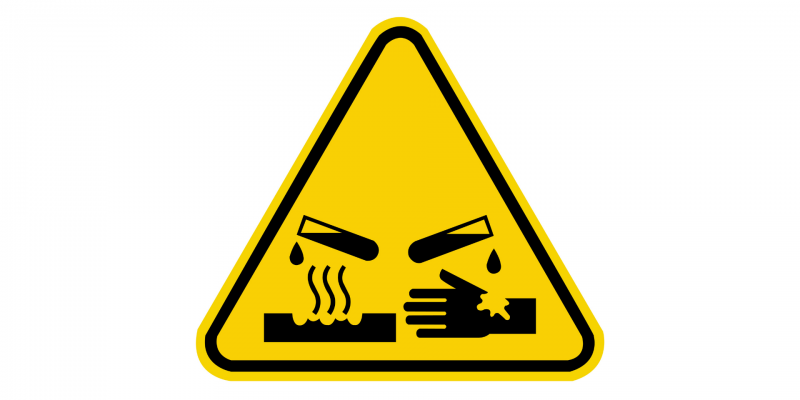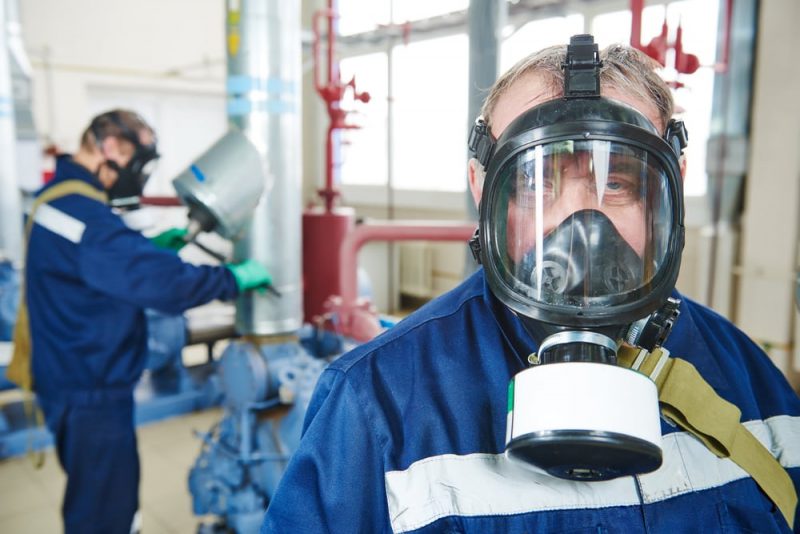The corrosive substances They are those capable of destroying or irreversibly damaging those surfaces with which they come into contact. For instance: sulfuric acid, zinc chloride, potassium hydroxide.
Corrosive substances they are dangerous for living beings. They can cause irritation or burns to the tissues of the skin, eyes, respiratory tract or gastrointestinal tracts that could well lead to death. This type of damage is known as chemical burns.
These types of materials should be used with means of protection appropriate: gloves, clothing, face masks. In places or containers where corrosive materials are deposited or contained, they must (according to international regulations) be marked with labels that have a standard icon representing corrosion.

Generally, corrosive substances have an extreme pH, that is, highly acidic or basic, although they can also be highly oxidizing substances or of another nature. In contact with organic matter, acids catalyze lipid hydrolysis or protein denaturation, which generates caloric energy and whose joint effect leads to the irreparable destruction of tissue. The basesInstead, they dry out organic matter in an extreme way.
Examples of corrosive substances

- Hydrochloric acid. With the formula HCl and also known as muriatic acid or etching, can be obtained from the reaction of sodium chloride (NaCl) with sulfuric acid (H2SW4), or also produce it during the burning of certain plastics. It is extremely corrosive and its concentrated solution has a pH lower than 1, which is why it is used as a reagent, industrial solvent or as a catalyst in obtaining other chemical substances.
- Nitric acid. Of formula HNO3, is a viscous liquid commonly used as a reagent in the laboratory. It is used to produce trinitrotoluene (TNT) or various fertilizers such as ammonium nitrate (NH4NO3). It can also be found dissolved in acid rain, a well-known environmental phenomenon resulting from the pollution of air humidity.
- Sulfuric acid. Its formula is H2SW4 and it is one of the most elaborate products in the world since it is often used to obtain fertilizers or to synthesize acids, sulfates or even in the petrochemical industry. It is also useful in the steel industry and in the manufacture of all types of batteries.
- Formic acid. Known as methanoic acid and formula CH2OR2, is the simplest of the organic acids, often secreted by insects such as the red ant (Formica rufa) or bees as a toxic defense mechanism. It is also produced by nettles, or it can be found in acid rain due to atmospheric pollution. In small amounts it can cause minor irritations, but despite being of natural origin it is a fairly strong acid.
- Concentrated acetic acid. Also called methylcarboxylic acid or ethanoic acid. Its chemical formula is C2H4OR2, and it is the acid in vinegar, which gives it its characteristic sour taste and smell. It is also an organic acid, like formic acid, but it is extremely weak, so its applications are varied and not risky. Even so, in very high concentrations it could be dangerous to health.
- Zinc chloride. Zinc chloride (ZnCl2) is a more or less white and crystalline solid very soluble in water, widely used in the textile industry and as a catalyst in the laboratory. It is not particularly toxic, but in the presence of water it reacts exothermically (even that in the ambient air) and can be particularly corrosive, especially to cellulose and silk.
- Aluminum chloride. Of formula AlCl3It is a compound that has acidic and basic properties at the same time, depending on how it is diluted. It is a poor electrical conductor when molten and has a low melting and boiling point. It is used in chemical processes as a catalyst for reactions, in wood preservation or in oil cracking. Exposure to this compound is extremely harmful to the body, since it can leave permanent sequelae in a short time of exposure.
- Boron trifluoride. Its formula is BF3 and it is a colorless toxic gas that forms white clouds in humid air. It is frequently used in the laboratory as lewis acid and in obtaining other compounds with boron. It is a very strong metal corrosive, which in the presence of humidity can corrode stainless steel.
- Sodium hydroxide. Caustic soda or caustic soda, with the formula NaOH, is a very desiccant base that exists as white crystalline and odorless solids, whose dissolution in water or an acid generates large amounts of heat. It is used in more or less pure percentages in the paper, textile and detergent industry, as well as in the oil industry.
- Potassium hydroxide. Known as caustic potash and with the chemical formula KOH, it is a highly desiccant inorganic compound, whose natural corrosivity is used in applications as a grease saponifier (in the production of soap). Its dissolution in water is exothermic, that is, it generates heat energy.
- Sodium hydride. With NaH formula, it is a substance that is very poorly soluble in organic solvents, it is transparent in color and is classified as a strong base since it is capable of deprotonizing various weak acids. In addition, it is a powerful desiccant, stores enormous amounts of hydrogen, is highly caustic, and highly flammable.
- Dimethyl sulfate. Under normal conditions, this compound of chemical formula C2H6OR4S is a colorless, oily liquid, with a slight onion odor, listed as a strong alkylator. It is highly toxic: carcinogenic, mutagenic, corrosive and poisonous, so its use in laboratory methylation processes is normally replaced with other safer reagents. It is also dangerous for the environment, which is why it has often been considered a probable chemical weapon.
- Phenol (carbolic acid). Chemical formula C6H6Or and numerous alternative names, this compound in its pure form is a white or colorless crystalline solid, which can be synthesized from the oxidation of benzene. It is highly demanded in the resin industry, as well as in the manufacture of nylon, but also as a component of fungicides, antiseptics and disinfectants. It is easily flammable and corrosive.
- Acetyl chloride. Also called ethanoyl chloride, it is a halide derived from ethanoic acid, which is colorless at room temperature and pressure. It is a compound that does not exist in nature, since in the presence of water it decomposes into ethanoic acid (C2H4OR2) and hydrochloric acid (HCl). It is widely used as a colorant, disinfectant, insecticide and even as an anesthetic despite being corrosive by reaction.
- Sodium hypochlorite. Known as bleach When dissolved in water, this compound with the chemical formula NaClO is a strong oxidant and reacts with chlorides to form lethally toxic gases of chlorine (Cl2). It is used as a bleach, water purifier and disinfectant, since in certain concentrations it has the ability to dissolve organic matter.
- Benzyl Chloroformate. It is an oily liquid with an unpleasant odor that can range from colorless to yellowish and has the chemical formula C8H7ClO2. It can be obtained by the reaction of phosgene with benzyl alcohol. It is carcinogenic and highly corrosive, dangerous for the environment and aquatic animals.
- Elemental alkali metals. Any alkali metal in its purest or elemental presentation, such as lithium (Li), sodium (Na), potassium (K), rubidium (Rb), cesium (Cs) and Francium (Fr), reacts very quickly with oxygen and water, so they are never seen in nature in its elemental state. In both cases they react violently, generating a lot of heat, which is why they can be irritating or caustic and dangerous to health.
- Diphosphorous pentoxide. Known as phosphorous oxide (V) or phosphoric oxide, is a white powder of molecular formula P2OR5. Being extremely hygroscopic (desiccant), has highly corrosive properties and its contact of any kind with the body should be avoided. Furthermore, its dissolution in water produces a strong acid that reacts in the presence of metals and generates poisonous and flammable gases.
- Calcium oxide. Call quicklime and with the chemical formula CaO, it is a substance long used by mankind, which has been obtained from limestone rock. It has applications in construction and agriculture since it is not toxic or corrosive, but when mixed with water it reacts exothermically, so it can irritate the respiratory tract, the skin or cause serious eye damage.
- Concentrated ammonia. Normally, ammonia, a colorless gas with a repulsive odor composed of nitrogen and hydrogen (NH3), is produced in various organic processes that release it to the environment due to its toxicity. In fact, it is present in human urine, and it can be released into the environment in the form of ammonia anhydride, which is very harmful and toxic.
